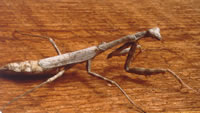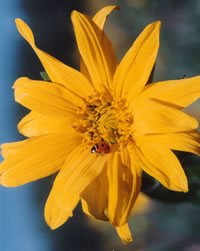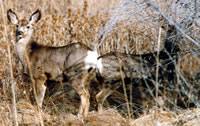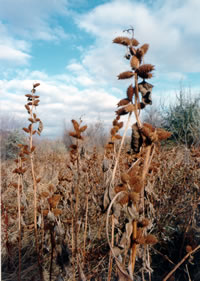|
September in the desert is not a glamorous time of year for
flowers. Sure, the sun-yellow blossoms cover the Chamisa and
skinny flags of Sagebrush plumes wave in the wind. Even Snowball
Buckwheat, also known as Fremont’s Buckwheat, resembles
a snow-covered shrub, its white flowers forming a dense flat-topped
appearance. Maybe those fickle late-summer rains will finally
arrive and send the Cliffrose into a second bloom. Mostly
though there are fewer species in bloom than during the spring,
and many of these autumnal bloomers are members of the Sunflower
Family.
One such member whose notoriety is often overlooked is the
Common Cocklebur. Disregarded because of its “weedy”
nature, these plants occur in fallow fields, wetlands, disturbed
sites and agricultural lands. They prefer moist sites to dry;
hence, you’ll rarely see one out in the dry lands -
except if that site might have held sufficient moisture at
some point in time.
A cocklebur seedling looks a lot like a young sunflower plant.
Pairs of long, elliptical leaves square off from each other.
As the season progresses, these annual plants grow taller
and put out an elephant ear-shaped leaf. These heart-shaped
leaves have long stems and toothed or lobed margins. The underside
of the leaf feels rough and sandy to the touch, much like
sharks’ skin. Depending upon conditions, these plants
might reach 3-4 feet tall. Their stout stems are purplish
green and be spotted with black or purple dots resembling
a case of the measles.
Both male and female flowers are borne on one plant. This
makes these plants monoecious (moan-e-schous) a word meaning
“one house.” Tight clusters of yellowish male
flowers resemble grape clusters, while the female flowers
are smaller and located just beneath these male clusters.
The clusters mature at different times to avoid self pollination.
The two-chambered bur that results from pollination grows
in size until it is roughly 1-2 inches long. The species name
for this Cocklebur plant - strumarium - is from a Greek word
meaning “cushion-like swelling.” However, that
cushion has some spiny character.
Covered with long, stiff, hooked spines, the seed pod turns
from a pale green to an ominous brown. The gaffing pole-like
spines imitate hitchhiker thumbs, sticking out and waiting
for a ride. When a furred animal wanders through the dense
thickets of these plants, these spines become entangled in
the animal’s fur. As the one pod breaks loose, often
a small shower of other pods rains down upon the now-irritated
animal. Sometimes the animal will pull loose the pod with
its teeth or claws, but often the pod takes a ride only to
be broken or pulled off somewhere in transit. Its job of dispersal
completed, the pod eventually breaks down and releases its
seeds.
Though many animals avoid these plants and seeds, because
of their toxicity, the Zuñi Indians ate these seeds
raw or cooked. A mixture of smashed seeds, squash and corn
was used externally to treat puncture wounds or to facilitate
the removal of splinters or spines. Though young plants contain
a glycoside named xanthostrumarin, which may prove toxic to
livestock if sufficient quantities are ingested, older leaves
have been used to treat nervous disorders, hysteria and even
colic.
Perhaps the greatest claim to fame for the Cocklebur was the
spawning of hook and clasp fasteners. Better known as VelcroTM,
the spiny, fur-sticking texture of the pod provided an inventor
with the basic concept.
As temperatures cool and the rains return, don’t forget
to check out some of the shaggier specimens of the late summer
Plant Kingdom. Strolling through a patch of Cocklebur you
might also scare up some Praying Mantis, predatory insects
hiding amongst these weeds. Though exploring these patches
is a whole different experience than a walk through in winter,
who knows, maybe you too will develop a new product that “sticks”
with us all.

|




|





